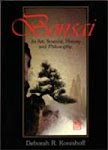
Masters Series “Junipers”
Compiled and edited by Wayne Schoech
and the Staff of Bonsai Today
ISBN 9780976755036 SC pp174
Published 2007
Stone Lantern Publishing
Having previously received and read “Pines” the Master Series, I looked forward in not only reading but adding this book to my reference library. This volume as with the former, is targeted towards the intermediate to advanced enthusiast. Having said that, the layout and descriptions are easily understood by any audience.
“Junipers” as with “Pines”, is a compilation of former articles that appeared in “Bonsai Today” magazine. To some, this avenue seems redundant. For others, who do not have the luxury of possessing every back issue of the periodical, it is indeed refreshing to see the forethought in the compilation of previously published articles under one binder. However, it is my understanding that the book does include information not previously published or found in former articles.
The book is divided into 18 comprehensive chapters from care basics to re-designing established bonsais, while displaying the talents of some of the best enthusiast in the world like, Kimura, Kobayashi and Hirao to name a few.
Chapter one begins with a comprehensive species guide suitable to bonsai cultivation, followed by the usual basic care and maintenance section. Once, one has begun compiling an extensive library, these basic sections become redundant. However, as always I did find fresh information to wit, an exquisite section on ramification. Of special note would be the seasonal chart found at the end of Chapter 2. This chart not only compiles monthly maintenance requirements but shows the different maintenance requirements between: cold, temperate and tropical climates, in an easily understood spreadsheet.
As we continue through the book we find a comprehensive section on various grafting and layering techniques, including a section on emergency treatment. As with “Pines” this work features many re-styling and transformation plates. What is readily seen, these transformation are more descriptive in comparison to what is commonly found in the limited available space of a magazine.

In my opinion as with “Pines” this is definitely a worthy addition to any reference library. Although the layout and photographs are easily followed in the re-styling section, in my opinion what stands out the most would be the comprehensive maintenance chart which includes the delta between climates. Far too often we have seen seasonal care described from the author's perspective only, Stone Lantern went one step further and, in doing so have gained my full endorsement. In my opinion, this chart alone outweighs the reasonable purchase price of this magnificent work. Once again I look forward in seeing their next volume.
If I was to criticize this book would be the binding method used. As with “Pines” it is poorly done in my opinion, and will fail over time.







No comments:
Post a Comment